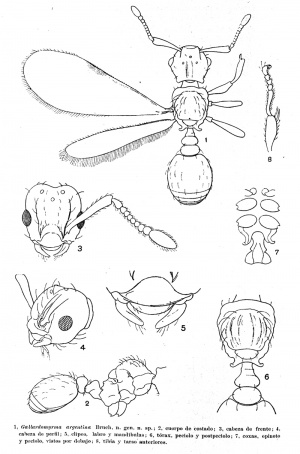Pheidole argentina
| Pheidole argentina | |
|---|---|
| Conservation status | |
| Scientific classification | |
| Kingdom: | Animalia |
| Phylum: | Arthropoda |
| Class: | Insecta |
| Order: | Hymenoptera |
| Family: | Formicidae |
| Subfamily: | Myrmicinae |
| Tribe: | Attini |
| Genus: | Pheidole |
| Species: | P. argentina |
| Binomial name | |
| Pheidole argentina (Bruch, 1932) | |
A permanent workerless parasite of Pheidole nitidula. (Wilson 2003)
| At a Glance | • Workerless Inquiline |
Identification
The original line drawing from Bruch (1932):
See the description in the nomenclature section.
Keys including this Species
Distribution
Only known from the type locality.
Latitudinal Distribution Pattern
Latitudinal Range: -31.016° to -31.657°.
| North Temperate |
North Subtropical |
Tropical | South Subtropical |
South Temperate |
- Source: AntMaps
Distribution based on Regional Taxon Lists
Neotropical Region: Argentina (type locality).
Distribution based on AntMaps
Distribution based on AntWeb specimens
Check data from AntWeb
Countries Occupied
| Number of countries occupied by this species based on AntWiki Regional Taxon Lists. In general, fewer countries occupied indicates a narrower range, while more countries indicates a more widespread species. |

|
Estimated Abundance
| Relative abundance based on number of AntMaps records per species (this species within the purple bar). Fewer records (to the left) indicates a less abundant/encountered species while more records (to the right) indicates more abundant/encountered species. |

|
Biology
Castes
This species is a workerless parasite.
Nomenclature
The following information is derived from Barry Bolton's Online Catalogue of the Ants of the World.
- argentina. Gallardomyrma argentina Bruch, 1932: 273, figs. 1-8 (q.) ARGENTINA. Combination in Pheidole: Wilson, 1984: 327. See also: Wilson, 2003: 267.
Unless otherwise noted the text for the remainder of this section is reported from the publication that includes the original description.
Description
From Wilson (2003): An extreme workerless parasite of Pheidole nitidula. The queen possesses a trait unique within the ants: the antenna is 10-segmented, with a well-developed, 1-segmented club. Also, the body is somewhat pupiform and the mandibles are reduced to toothless straps.
MEASUREMENTS (mm) Syntype queen: according to Bruch (1932), the total length of a queen in the type series is 1.7 mm.
COLOR Head, especially vertex, brownish yellow; mesosoma, waist, and gaster (except the apex) grayish brown.
Figure. Syntype, queen. (Adapted from Bruch 1932.) Scale bars = 1 mm.
Type Material
ARGENTINA: Alta Gracia (La Granja), Sierra de Córdoba, col. Carlos Bruch. Museo de La Plata, Argentina - as reported in Wilson (2003)
Etymology
Named after the country of origin. (Wilson 2003)
References
- Wilson, E. O. 2003. Pheidole in the New World: A dominant, hyperdiverse ant genus. Harvard University Press, Cambridge, MA. (page 267, fig. queen described)
- Brown, W. L., Jr. 1973b. A comparison of the Hylean and Congo-West African rain forest ant faunas. Pp. 161-185 in: Meggers, B. J., Ayensu, E. S., Duckworth, W. D. (eds.) Tropical forest ecosystems in Africa and South America: a comparative review. Washington, D.C.: Smithsonian Institution Press, viii + 350 pp. (page 180, Combination in Pheidole)
- Bruch, C. 1932. Descripción de un género y especie nueva de una hormiga parásita (Formicidae). Rev. Mus. La Plata 33: 271-275. (page 273, figs. 1-8 queen described)
- Ferreira, A., Martins, M., Feitosa, R. 2016. Rediscovery of the morphologically remarkable social parasite Pheidole acutidens (Bruch), with the first records for Brazil. Sociobiology 63, 1069. (doi:10.13102/sociobiology.v63i4.1263).
- Wilson, E. O. 1984b. Tropical social parasites in the ant genus Pheidole, with an analysis of the anatomical parasitic syndrome (Hymenoptera: Formicidae). Insectes Soc. 31: 316-334 (page 327, Combination in Pheidole)
References based on Global Ant Biodiversity Informatics
- Kempf, W.W. 1972. Catalago abreviado das formigas da regiao Neotropical (Hym. Formicidae) Studia Entomologica 15(1-4).


